Horse Trekking with Tibetan Nomads
After two weeks of gray skies in Hong Kong and Chengdu, Alissa and I have ventured further north into China to get some fresh air and see what China used to be like before its days of speedy construction and growth. We first spent two days at Jiuzhaigou National Park, which was interesting and beautiful, however it still felt like new China, not the old.
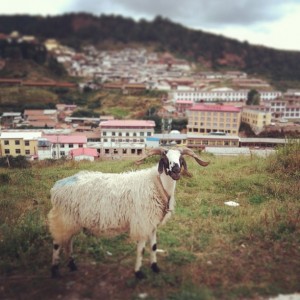 The Village of Langmusi
The Village of Langmusi
We caught the morning bus from Jiuzhaigou to a small Tibetan village six hours north called Langmusi. This town, and the surrounding area’s elevation is 11,000 feet, about twice that of Denver! We were a little worried about altitude sickness, especially since neither of us have ever been at this elevation before. However, after spending our first day here relaxing and getting to know the town, we have had no issues with the altitude.
However, we have had some problems with the temperature. We’ve spent six months in SouthEast Asia, and we have never had a day with a temperature below 70°F/21°C. To be thrown into a town with temperatures around 40°F/4°C is quite a shock, and we do not have the proper warm clothes in our small carry-on bags to handle this. We are planning on renting traditional Tibetan clothes for our horse trek, but during the other days we have resorted to being as Minnesotan as possible and just sucking it up. When we’re outside we just walk pretty fast from place to place.
The Horse Trek
Langmusi is the smallest town we’ve visited while in China, and yet we found one the best English-speaking Chinese person of our entire trip in here. Her name is Liyi, and she and her husband own both the best horse-trekking outfit in town, as well as the best cafe in town. (they even have Yak Pizza on the menu!) Liyi has set us up with a local guide who will take us on horseback tomorrow through the nearby mountainside all the way to his nomadic tent to spend the night with him and his wife before trekking back to town the next morning. We’ve even been able to rent traditional Tibetan clothes to ensure we will be warm enough for the trip. It gets pretty cold at night and whenever the sun isn’t shining.
Leaving town
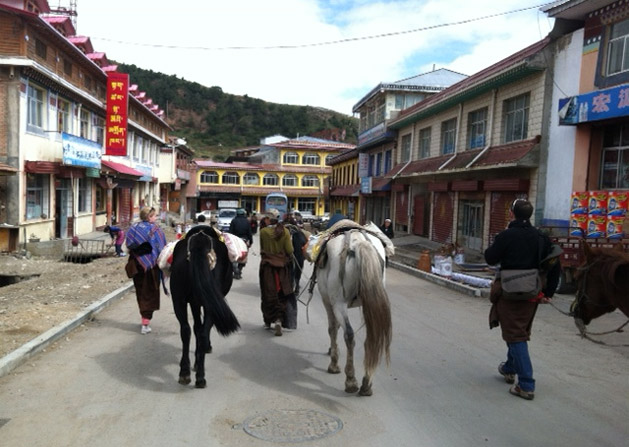
Something interesting about the village of Langmusi is that it will not be a village for long. The entire city is under construction, including the construction of 40-50 brand new buildings. There are two or three streets being created with an entire row of new buildings alongside. It’s like nothing I’ve ever seen before. This village will be 4-5 times bigger by the end of next year.
We are joined by another young couple for the first part of our trek today: David from Zimbabwe and Katrin from Estonia. After receiving a 30-minute horse riding tutorial (I’ve never been on a horse before, BTW), we head out of town, walking our horses alongside the road. There are a lot of monks from the nearby monasteries who are in town today to shop, and each one of them stops to stare and laugh at the four white people leading horses out of the town.
Heading into the mountains
The first two hours of riding are incredible. The horses are great, the weather is perfect, and the company is even better. We love meeting other travelers, and the diverse backgrounds of our fellow travelers today have created some great conversations and discussions. I was a little worried about whether or not I would be able to successfully ride a horse, but after these first few hours, I feel a lot more confident. Our biggest issue is trying to keep the horses from constantly eating grass. Anytime we stop for even a second or two the horses instantly try to put their heads down and eat. The guides tell us to not let them eat until we stop for lunch, where the horses will have over an hour to eat as much as they want. I don’t really like getting in-between an animal of this size and his lunch…
Lunch break
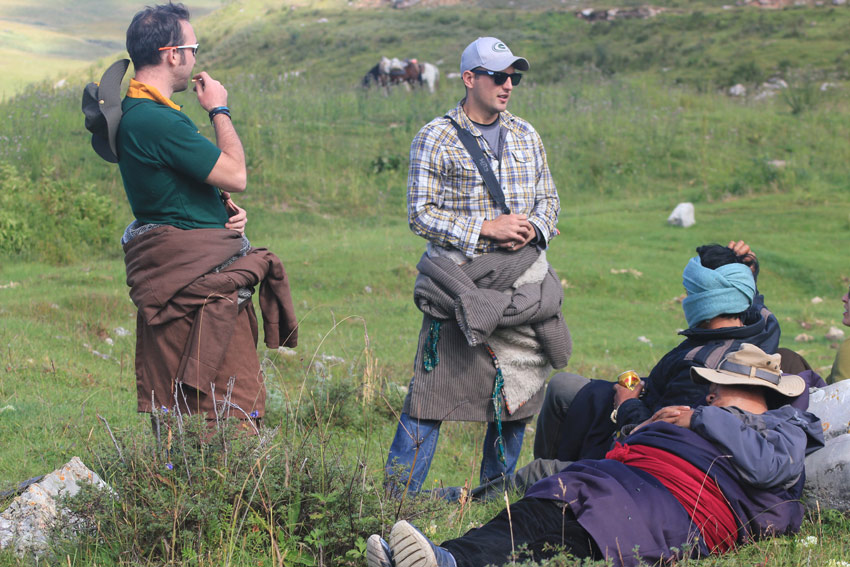
We stop for lunch in an area called the “Source of White Dragon River”. The view of the mountains from here is amazing, and there is a mountain spring right nearby that we are able to drink directly from(the source of the river I presume). The water is fresh and cold, a stark contrast to the drinking water in Chinese mega-cities like Shanghai. Our lunch is cooked by a local Tibetan woman in her Yak-skin hut. Like all nomad huts in this area, the stove inside uses dried Yak dung as fuel. Although I wish I hadn’t seen her add a big pile of dung to the fire with her bare hands right before grabbing and chopping the tomatoes. Not sure that would pass a health inspection back in the States. After an hour, we say goodbye to the local woman who cooked for us and her son and get back on the horses.
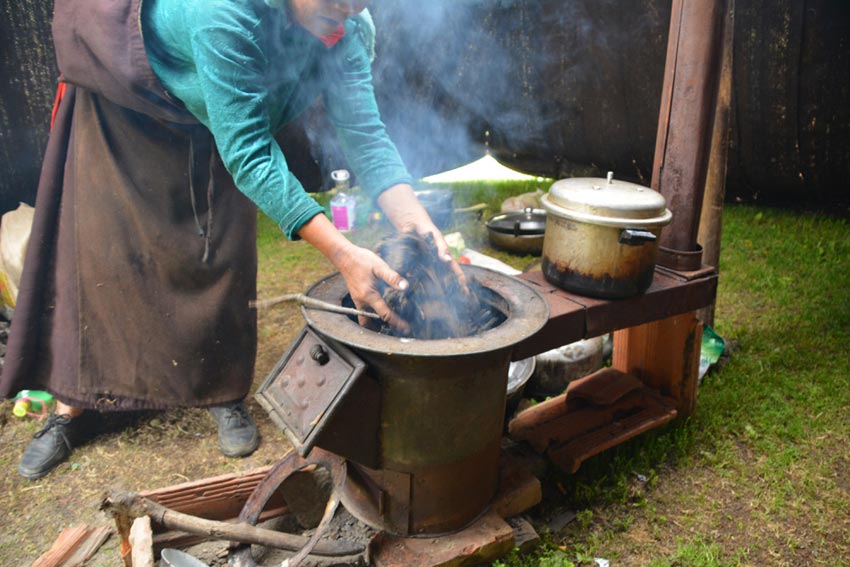
The Ocean of Flowers
After another three hours on the horses, winding our way up, down, and around the mountains, we arrive in an area known as the Flower Ocean, or Ocean of Flowers. This is where all the nomads live and work most of the year. The grasslands seem to go on forever, and it takes us another hour to make our way to our host’s tent. There are Yak everywhere. I mean everywhere. Each piece of grassland in this area is owned by a different family, and each family packs their land with as many yaks, horses, and sheep as they can. It’s so peaceful and beautiful to ride through. It reminds me of when Kevin Costner sees a herd of buffalo for the first time in the movie Dances with Wolves.
The home of a Tibetan nomad
The combination of having to constantly remind my horse it’s not time to eat and the pain in my groin from the uncomfortable saddle has made me more than ready to arrive at our guide’s tent and call it a night. His tent is located on the top of a small hill within the Ocean of Flowers, and it overlooks the land where is livestock spend all day grazing. When we arrive we are greeted by his wife, who only has about 30 seconds to talk to us before having to head back down to the well to fetch more water.
The hardest working women in the world
One thing we were told before the trek was that the culture of Tibetan nomads dictates the women working from sun up to sun down, with the men doing much less work. We weren’t sure how true this would be, but it couldn’t be more true. From the moment we arrived, our guide’s wife was working, and she didn’t stop working until we left. Here is a typical day in the life of a woman here:
4:00 am: Wake up and milk the yaks
6:00 am: Walk to the river to get water
7:00 am: Make yak butter
8:00 am: Cook breakfast for your husband (who is just waking up)
9:00 am: Begin collecting yak dung by hand from the fields as your husband leads the animals out to graze.
11:00 am: Spread the yak dung out by hand near your tent to dry it out so it can be used as fuel.
1:00 pm: Cook lunch for yourself (and your husband if he isn’t in town drinking tea with his buddies)
3:00 pm: Make yak yogurt
5:00 pm: Walk to the river to get more water
6:00 pm: Collect dried yak dung and add it to the dung pile in your tent
7:00 pm: Help your husband bring the yak and sheep herds back to your hill and tie them all up.
8:00 pm: Begin cooking dinner for your husband who is chain smoking and looking at random cellphone pictures. In our case, photos of NBA players.
9:30 pm: Eat whatever food is left over.
10:00 pm: Clean the tent and prepare the beds.
11:00 pm: Goes to bed so you can do it all over again at 4am the next morning.
Here’s the ever-growing pile of dried yak dung collected by our hosts that cook up 1/4 of our tent:
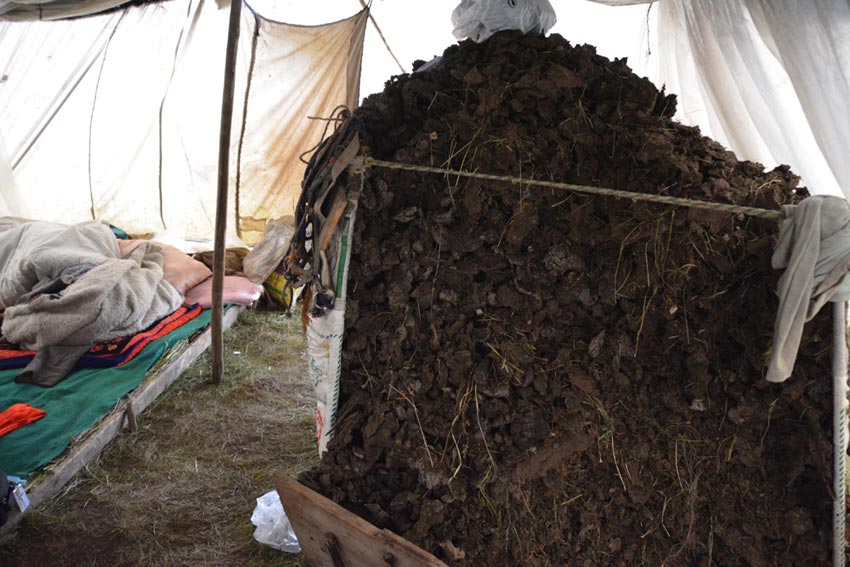
It was hard not to be in awe of this woman. We only observed 12 hours of her life and it looked exhausting. I can’t believe she does it every day, and it make me feel bad for ever complaining that sitting at a desk for eight hours made me tired. At least I can go home and take a nice hot shower after a long day in the office. We asked some locals in town if these women are upset that they do so much more work than the men. They said that the women are proud of their hard working culture and that it is how they want to continue to live. To allow your husband to help you would mean losing face in the community. It was some of the biggest culture shock we’ve experienced on this trip, and I hope when we get back to the U.S. that we can also adopt this “women do everything” culture into our home. (doubt it)
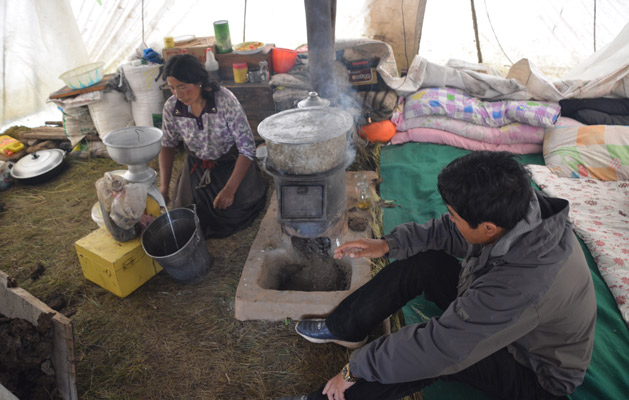
8:00am: The woman of the house churns butter while the man just sits and smokes. The woman has been up since 4am. The man just woke up.
The dinner was fresh noodles (made from scratch), various vegetables in a soup, and dried yak jerky thrown in from some protein. Again, I wish I hadn’t watch her cook it. She grabs a hunk of dung from the pile, throws it into the fire, then begins tearing the noodles into pieces with those same hands. I guess it all gets boiled anyways right? Sanitation concerns aside, the food was actually quite good, although I’m sure it gets old for them really fast, as there doesn’t seem to be a big variety of dinners available to cook up here.
Sleeping in the tents
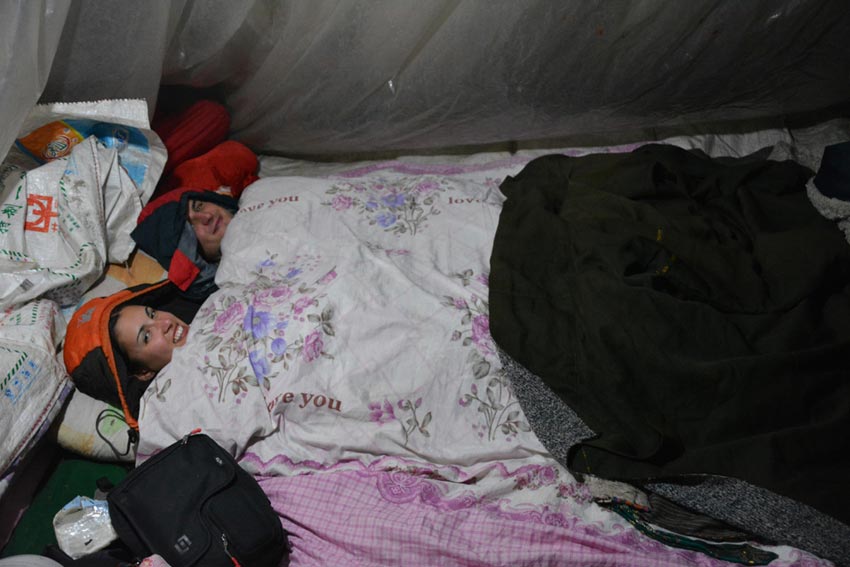
It gets pretty cold at night here, and the fire goes out pretty much right after dinner. This leaves us using three or four blankets each to keep us warm. The temperature drops to about 38ºF/3ºC at night and it’s the first time in my life I’ve ever had to bundle up this much to stay warm at night. It’s tough to sleep with the wind constantly blowing on the outside of the tent, and the spiders that keep crawling on me, however eventually we are able to fall asleep. Of course, we awake around 5:00am to see our host’s wife already working away at boiling milk she had just pumped. She let me taste some, and although I prefer cold milk, this yak milk was much better than I expected. We are also given fresh chinese tea in old tomato sauce jars. Overall, a nice, authentic Tibetan morning.
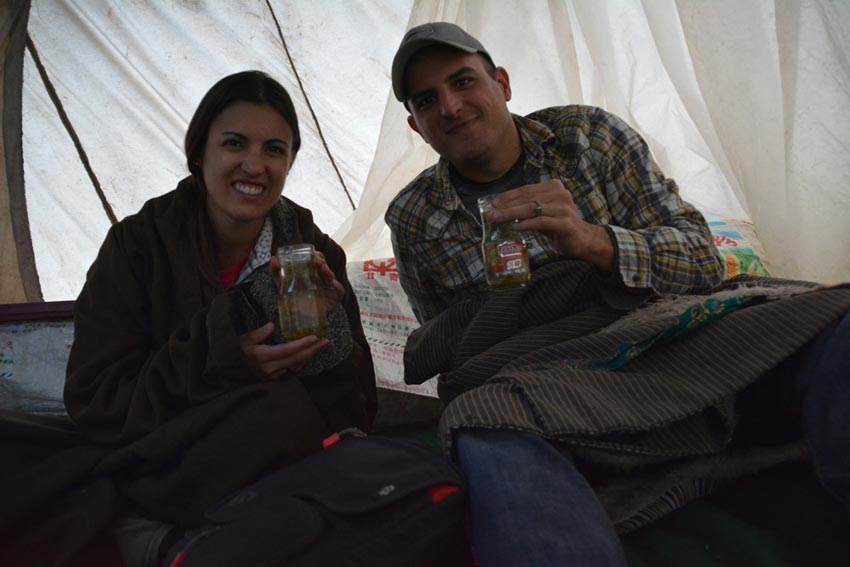
Heading back to town
The ride home is just as scenic as yesterday. Although the riding is a bit different. This time, not only do we have the three horses we’re riding, but we have an additional three horses that we are herding back to town. If there is any moment in my life were I legitimately feel like a cowyboy, then this is it. And I’m not talking about that feeling you get a Alan Jackson concert, but the feeling of being a real cowboy. To be honest, it’s actually quite annoying being a cowboy. The horses never listen to me, and I have to constantly ride to the other side of them and make that clicky noise with my mouth to get them to go the direction we want. If we look away for any time at all, they will start eating the grass. After three hours of this, I know for a fact I am not talented enough to be a cowboy, but hey, neither is Tony Romo right?
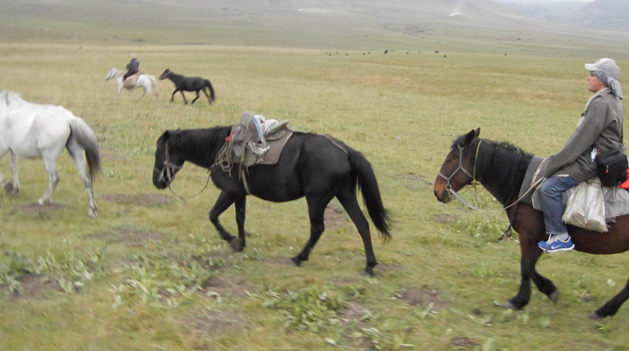
Final thoughts from the trek
Having done nothing even remotely close to this before, it is hard to describe just how surreal it is to be doing something like it. FOREIGN is the word that comes to my mind the most when trying to describe what it’s like. I had never even been on a horse, and I’ve never slept in a tent that wasn’t inside some sort of campground. I’ve never drank fresh milk like that either, and I grew up in the Dairyland of the United States. Doing so many things foreign to what you’re used to can be very uncomfortable, but it can also be very rewarding. This 36 hour trip is definitely one of our top experiences of the past year, and is something we’ll remember forever. Next time Alissa asks me to get up off the couch and turn the thermostat up, instead of grumbling, I will just do it and be thankful I am not watching her shovel yak dung into a stove.
Here is the Facebook Album of pictures from the horse trek:
[fbalbum url=”https://www.facebook.com/media/set/?set=a.429152857201150.1073741839.313060352143735″]
.
Our trip to Hong Kong and China is being sponsored by eDreams

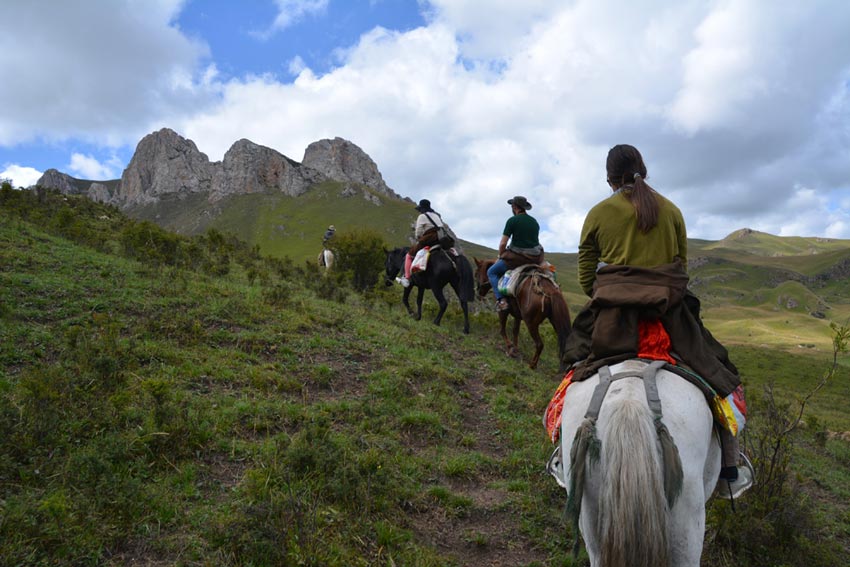
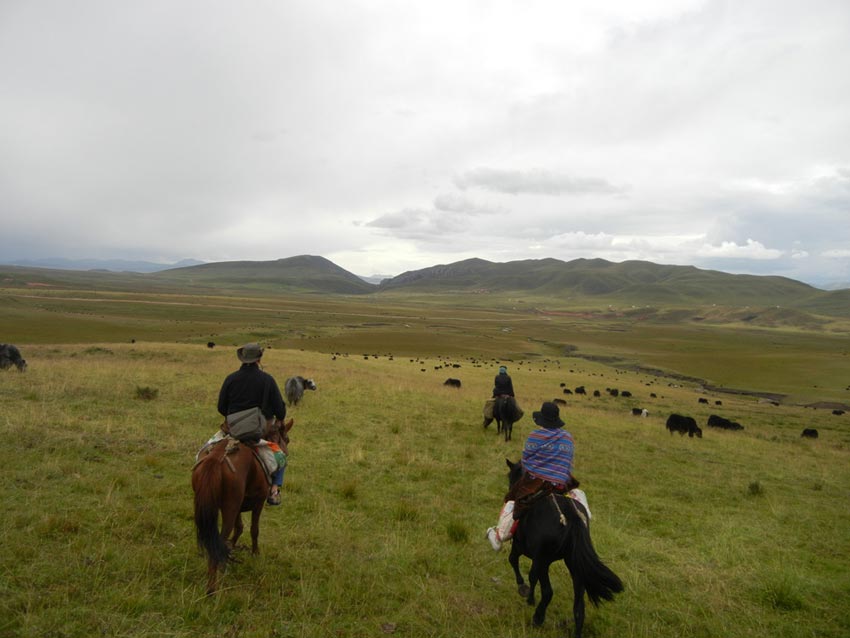
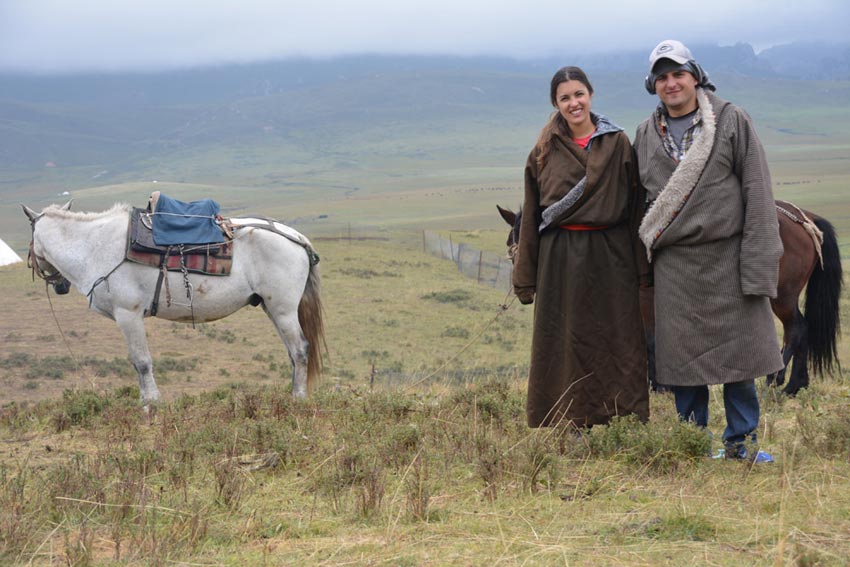
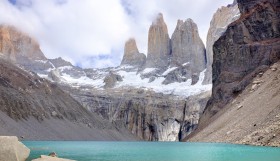
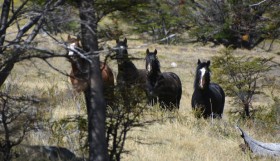
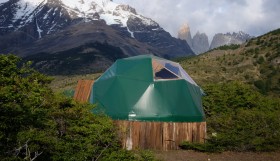
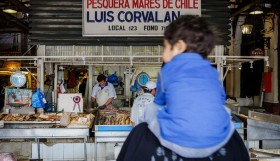















Pingback: This World Rocks | Our Favorite City in China: Xi'an and the Terracotta Army | This World Rocks |
Pingback: This World Rocks Alissa's Top Five Memorable Experiences in 8 Months in Asia and the South Pacific | This World Rocks
Pingback: This World Rocks Looking Back on One Year of Travel and Future Plans | This World Rocks
Pingback: This World Rocks All Good Things Must End: Lessons from 18 Months on the Road with Tears on My Keyboard | This World Rocks